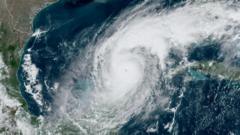In anticipation of the upcoming 2025 Atlantic hurricane season, the National Oceanic and Atmospheric Administration (NOAA) has warned that a busier season than usual could be on the horizon. The prediction stands at approximately six to ten hurricanes, slightly above the typical average. Climate change, with its impact on sea temperatures and atmospheric conditions, plays a significant role in this forecast. Current warm sea conditions, although not as extreme as the previous year, and the absence of El Niño - which generally hampers hurricane formation - contribute to NOAA's expectations for an uptick in storm activity.
However, as forecasters look ahead, they are also grappling with a troubling climate of uncertainty stemming from significant staffing cuts at NOAA, which have sparked worries about the agency's capability to effectively monitor and predict these powerful storms. Hundreds of researchers have been laid off under the administration of President Trump, raising questions about the operational capacity of the National Weather Service, which is pivotal for timely hurricane forecasts and hazard warnings.
Experts warn that the downsizing of NOAA staff could lead to burnout among remaining members who are striving to maintain accurate forecasting standards amid heightened demands. Critical positions, especially in hurricane-prone areas like Texas, are reportedly vacant, impacting decision-making and operational readiness. Moreover, the potential loss of atmospheric data collection, including essential data from weather balloon launches, poses a risk to the integrity of storm forecasting.
Overall, while the predictions for the hurricane season may appear concerning yet manageable, the cutbacks at NOAA could have dire implications, not just locally, but globally, as they may hinder comprehensive atmospheric understanding necessary for effective weather forecasting. Dr. Daniel Swain of UCLA articulated concerns that the staffing cuts represent only the beginning of an ongoing problem, which, if left unaddressed, could jeopardize lives during critical weather events. As the new season approaches, the cooperation of a skilled meteorological workforce remains paramount to confront the looming threat of hurricanes effectively.
However, as forecasters look ahead, they are also grappling with a troubling climate of uncertainty stemming from significant staffing cuts at NOAA, which have sparked worries about the agency's capability to effectively monitor and predict these powerful storms. Hundreds of researchers have been laid off under the administration of President Trump, raising questions about the operational capacity of the National Weather Service, which is pivotal for timely hurricane forecasts and hazard warnings.
Experts warn that the downsizing of NOAA staff could lead to burnout among remaining members who are striving to maintain accurate forecasting standards amid heightened demands. Critical positions, especially in hurricane-prone areas like Texas, are reportedly vacant, impacting decision-making and operational readiness. Moreover, the potential loss of atmospheric data collection, including essential data from weather balloon launches, poses a risk to the integrity of storm forecasting.
Overall, while the predictions for the hurricane season may appear concerning yet manageable, the cutbacks at NOAA could have dire implications, not just locally, but globally, as they may hinder comprehensive atmospheric understanding necessary for effective weather forecasting. Dr. Daniel Swain of UCLA articulated concerns that the staffing cuts represent only the beginning of an ongoing problem, which, if left unaddressed, could jeopardize lives during critical weather events. As the new season approaches, the cooperation of a skilled meteorological workforce remains paramount to confront the looming threat of hurricanes effectively.




















